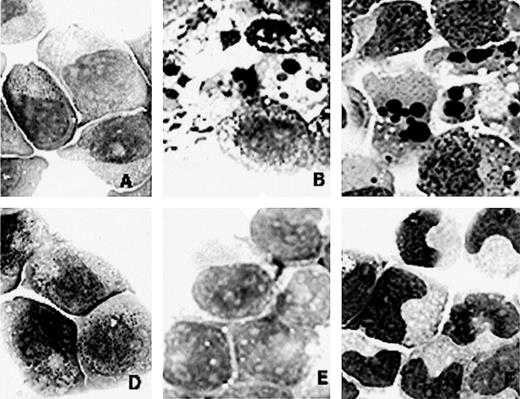To The Editor:
In a recent issue of Blood, Fanelli et al1 reported that constitutive degradation of PML-RARα through the proteasome pathway mediates retinoic acid (RA)-resistance in a derivative cell line of NB4 (NB4.007/6). The context of this study contradicts our hypothesis that the degradation of PML-RARα is important as a trigger of RA-dependent differentiation,2 3 although the conclusion is reasonable that PML-RARα expression is crucial to RA-sensitivity. To resolve the complexity of the relationship between the degradation of PML-RARα and differentiation, we hope to elucidate the following.
Firstly, it must be determined whether the sequences ofPML-RARα and RARα genes are normal or mutated in NB4.007/6. In some RA-resistant APL cell lines, mutations of the PML-RARα gene have been reported in the AF-2 domain, which is important to ligand-binding.3-5 Because a missense mutation and a premature termination potentially cause instability of the protein, the constitutive degradation of PML-RARα might be due to the mutation.
Secondly, the investigators did not present the immunostaining data of endogenous PML or PML-RARα in NB4.007/6. Because PML-RARα was quickly degraded, the immunostaining pattern might resemble the wild pattern. However, the investigators stained exogenous PML-RARα carrying green fluorescent protein (GFP), which showed a microgranular pattern. This data showed the short life of PML-RARα but not the subcellular localization.
Finally, our recent data suggested that constitutive degradation of PML-RARα is not necessarily associated with RA-resistance. We established a new subline of NB4 (NB4/As) that showed resistance to As2O3: continuous growth without apoptosis and differentiation in the medium containing 1 μmol/L As2O3. In immunoblot analysis, a PML-RARα band of this cell line disappeared in the presence with As2O3 and reappeared after the removal of As2O3 (data not shown). As2O3 is known to modify PML as well as to accelerate the degradation of PML-RARα.6-8 Although the molecular mechanism of the As-resistance is under investigation, the addition of RA differentiated NB4/As and increased the nitroblue tetrazolium (NBT) reduction activity even in the coculture with As2O3 (Fig 1).
Morphology of NB4 (A, B, and C) and NB4/As (D, E, and F) cell lines on RA or the combination of RA and As2O3 treatment. (A and D) Before treatment. (B and E) After 1 day of treatment with 1 μmol/L As2O3. (C) After 1 day of treatment with 1 μmol/L all-trans RA and 1 μmol/L As2O3. (F) After 4 days of treatment with 1 μmol/L RA and 1 μmol/L As2O3.
Morphology of NB4 (A, B, and C) and NB4/As (D, E, and F) cell lines on RA or the combination of RA and As2O3 treatment. (A and D) Before treatment. (B and E) After 1 day of treatment with 1 μmol/L As2O3. (C) After 1 day of treatment with 1 μmol/L all-trans RA and 1 μmol/L As2O3. (F) After 4 days of treatment with 1 μmol/L RA and 1 μmol/L As2O3.
We considered that the pathophysiology of NB4.007/6 might have changed from the parental cell line after culture with RA. Additional molecular changes increase the complexity of the RA-resistance in NB4.007/6. Investigation of the RA-resistance cell lines has shown that PML-RARα is a direct target molecule for RA. However, the relationship between the degradation of PML-RARα and differentiation remains to be resolved.
Response
One of the conclusions of our report1-1 is that PML/RARα itself mediates RA-dependent differentiation and that its degradation by RA is not crucial for the differentiation process to occur. Naoe and Kitamura disagree.
In general, we think that there is much direct and indirect evidence to support these conclusions: (1) PML/RARα is an RA-dependent transcriptional activator1-2,1-3; (2) PML/RARα mediates RA-induced differentiation in both APL and non-APL cells; in particular, PML/RARα restores RA-sensitivity in RA-resistant cell lines carrying mutations of RARα1-4,1-5; (3) commitment to differentiation in the presence of RA occurs within the first 12 hours, when PML/RARα is still detectable1-6; (4) inhibition of PML/RARα degradation by caspase inhibitors (another mediator of RA-induced degradation of the fusion protein) increases RA-induced differentiation in APL cells1-7; and (5) PML/RARα re-expression restores RA-sensitivity in RA-resistant APL cells with constitutive degradation of the fusion protein.1-1
With respect to some specific criticisms of Naoe and Kitamura: (1) we did not sequence RARα and PML/RARα transcripts in NB4.007/6 cells. Therefore, as suggested, we cannot exclude that mutations of the PML/RARα coding sequence might affect fusion protein stability. However, we think that other mechanisms are more likely, because exogenous PML/RARα (GFP-PML/RARα) or PML/RARα from parental NB4 cells were equally degraded in NB4.007/6 cells in infection and in vitro degradation assay, respectively. (2) Immunostaining of NB4.007/6 cells showed a micropunctuated pattern, typical of PML/RARα expression. Because we did not detect PML/RARα by Western blotting, this might reflect a better efficiency of our PG-M3 anti-PML monoclonal antibody on undenatured, versus denatured, antigens.
Finally, Naoe and Kitamura mentioned the isolation of an arsenic-resistant/RA-sensitive NB4 subline. Because the signaling pathway triggered by arsenic is yet undefined, we do not think that this model system can provide information as to the role of PML/RARα in RA-signaling.


This feature is available to Subscribers Only
Sign In or Create an Account Close Modal